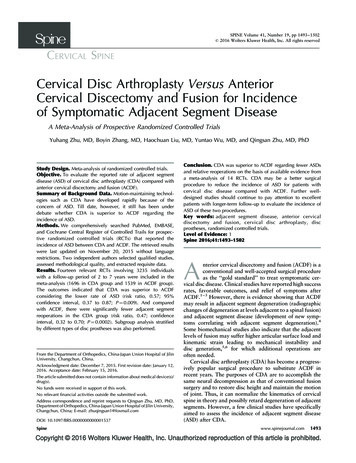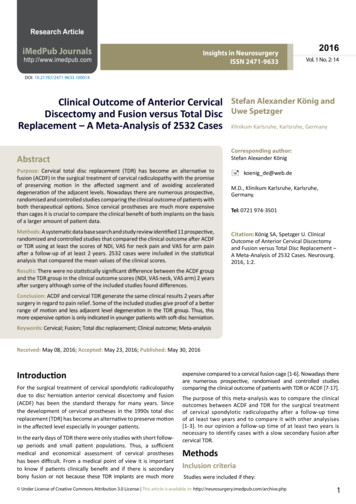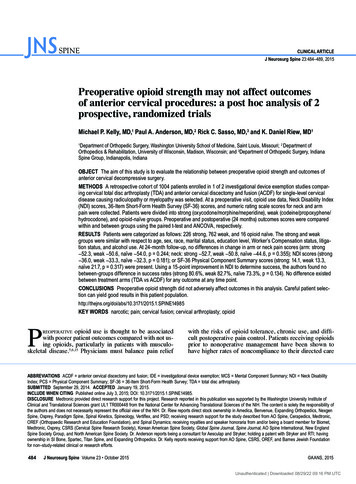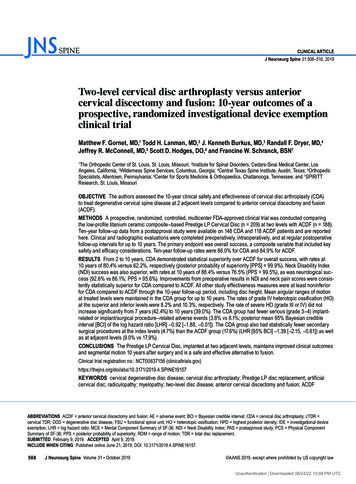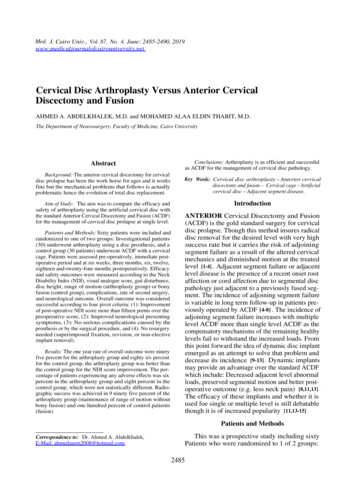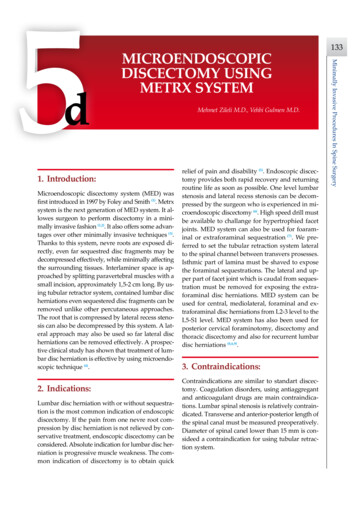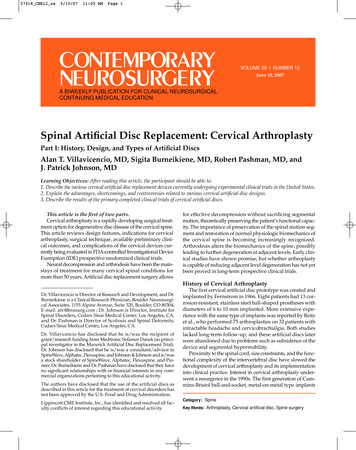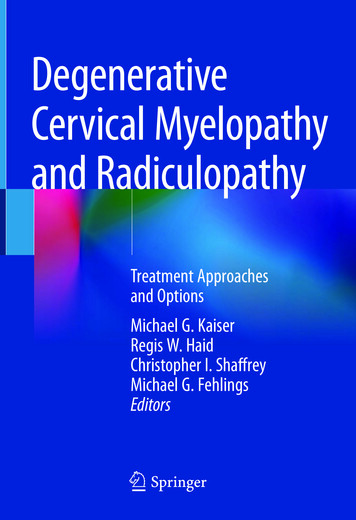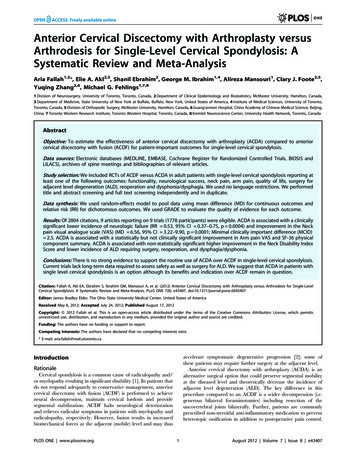
Transcription
Anterior Cervical Discectomy with Arthroplasty versusArthrodesis for Single-Level Cervical Spondylosis: ASystematic Review and Meta-AnalysisAria Fallah1,2*, Elie A. Akl2,3, Shanil Ebrahim2, George M. Ibrahim1,4, Alireza Mansouri1, Clary J. Foote2,5,Yuqing Zhang2,6, Michael G. Fehlings1,7,81 Division of Neurosurgery, University of Toronto, Toronto, Canada, 2 Department of Clinical Epidemiology and Biostatistics, McMaster University, Hamilton, Canada,3 Department of Medicine, State University of New York at Buffalo, Buffalo, New York, United States of America, 4 Institute of Medical Sciences, University of Toronto,Toronto, Canada, 5 Division of Orthopedic Surgery, McMaster University, Hamilton, Canada, 6 Guang’anmen Hospital, China Academy of Chinese Medical Science, Beijing,China, 7 Toronto Western Research Institute, Toronto Western Hospital, Toronto, Canada, 8 Krembil Neuroscience Center, University Health Network, Toronto, CanadaAbstractObjective: To estimate the effectiveness of anterior cervical discectomy with arthroplasty (ACDA) compared to anteriorcervical discectomy with fusion (ACDF) for patient-important outcomes for single-level cervical spondylosis.Data sources: Electronic databases (MEDLINE, EMBASE, Cochrane Register for Randomized Controlled Trials, BIOSIS andLILACS), archives of spine meetings and bibliographies of relevant articles.Study selection: We included RCTs of ACDF versus ACDA in adult patients with single-level cervical spondylosis reporting atleast one of the following outcomes: functionality, neurological success, neck pain, arm pain, quality of life, surgery foradjacent level degeneration (ALD), reoperation and dysphonia/dysphagia. We used no language restrictions. We performedtitle and abstract screening and full text screening independently and in duplicate.Data synthesis: We used random-effects model to pool data using mean difference (MD) for continuous outcomes andrelative risk (RR) for dichotomous outcomes. We used GRADE to evaluate the quality of evidence for each outcome.Results: Of 2804 citations, 9 articles reporting on 9 trials (1778 participants) were eligible. ACDA is associated with a clinicallysignificant lower incidence of neurologic failure (RR 0.53, 95% CI 0.37–0.75, p 0.0004) and improvement in the Neckpain visual analogue scale (VAS) (MD 6.56, 95% CI 3.22–9.90, p 0.0001; Minimal clinically important difference (MCID) 2.5. ACDA is associated with a statistically but not clinically significant improvement in Arm pain VAS and SF-36 physicalcomponent summary. ACDA is associated with non-statistically significant higher improvement in the Neck Disability IndexScore and lower incidence of ALD requiring surgery, reoperation, and dysphagia/dysphonia.Conclusions: There is no strong evidence to support the routine use of ACDA over ACDF in single-level cervical spondylosis.Current trials lack long-term data required to assess safety as well as surgery for ALD. We suggest that ACDA in patients withsingle level cervical spondylosis is an option although its benefits and indication over ACDF remain in question.Citation: Fallah A, Akl EA, Ebrahim S, Ibrahim GM, Mansouri A, et al. (2012) Anterior Cervical Discectomy with Arthroplasty versus Arthrodesis for Single-LevelCervical Spondylosis: A Systematic Review and Meta-Analysis. PLoS ONE 7(8): e43407. doi:10.1371/journal.pone.0043407Editor: James Bradley Elder, The Ohio State University Medical Center, United States of AmericaReceived May 8, 2012; Accepted July 24, 2012; Published August 17, 2012Copyright: ß 2012 Fallah et al. This is an open-access article distributed under the terms of the Creative Commons Attribution License, which permitsunrestricted use, distribution, and reproduction in any medium, provided the original author and source are credited.Funding: The authors have no funding or support to report.Competing Interests: The authors have declared that no competing interests exist.* E-mail: aria.fallah@mail.utoronto.caaccelerate symptomatic degenerative progression [2]; some ofthese patients may require further surgery at the adjacent level.Anterior cervical discectomy with arthroplasty (ACDA) is analternative surgical option that could preserve segmental mobilityat the diseased level and theoretically decrease the incidence ofadjacent level degeneration (ALD). The key difference in thisprocedure compared to an ACDF is a wider decompression (i.e.generous bilateral foraminotomies) including resection of theuncovertebral joints bilaterally. Further, patients are commonlyprescribed non-steroidal anti-inflammatory medication to preventheterotopic ossification in addition to postoperative pain control.IntroductionRationaleCervical spondylosis is a common cause of radiculopathy and/or myelopathy resulting in significant disability [1]. In patients thatdo not respond adequately to conservative management, anteriorcervical discectomy with fusion (ACDF) is performed to achieveneural decompression, maintain cervical lordosis and providesegmental stabilization. ACDF halts neurological deteriorationand relieves radicular symptoms in patients with myelopathy andradiculopathy, respectively. However, fusion results in increasedbiomechanical forces at the adjacent (mobile) level and may thusPLOS ONE www.plosone.org1August 2012 Volume 7 Issue 8 e43407
Comparing Cervical Arthroplasty to FusionAlthough several randomized clinical trials (RCTs) havecompared ACDF to A [5–9], it remains unclear whether ACDAresults in improved patient-important outco [4,10] and whether ornot its widespread use should be advocated. A systematic reviewfound that ACDA results in modest clinical benefits with respect toneck pain, arm pain and quality of life compared to ACDF at12 month follow-up, most of which were not sustained at 2 yearfollow-up [4]. A recent review of 3 United States Food and DrugAdministration cervical arthroplasty trials concluded that ACDAmay be associated with a higher rate of neurological success andlower prevalence of ALD 2 years following surgery [10].There are no systematic reviews that have assessed publicationbias, evaluated the risk of bias of included trials, interpreted theresults with respect to clinical significance, evaluated the quality ofHeterotopic ossification is most commonly described as acomplication of large joint arthroplasty and is the main cause ofthe prosthesis to lose function [3]. Its prevalence in cervicalarthroplasty is 58.2% (95% CI 29.7–86.8%) 12 months aftersurgery [3]. In addition, ACDA is a technically more difficultoperation to perform compared to an ACDF.If ALD is truly decreased, this procedure may result indecreased disability, decreased incidence of reoperation andincreased quality of life while achieving similar rates of neurological success. If not, the use of ACDA increases health care costswithout any additional neurological benefit [4] and a potential ofgreater harm if performed by a non-expert surgeon. Further, thelong-term risks associated with ACDA may not be as welldelineated compared to the more commonly performed ACDF.Figure 1. PRISMA 2009 Flow Diagram.doi:10.1371/journal.pone.0043407.g001PLOS ONE www.plosone.org2August 2012 Volume 7 Issue 8 e43407
PLOS ONE www.plosone.org3ChinaWang et. al2008[22,25]30–50 21N/A20–6018–6518–6518–6018–60.18Single levelsymptomaticDDD, C3-7Single iculopathyonly) DDDSingle levelsymptomatic(Radiculopathyonly) DDD, C3-7Single levelsymptomaticDDD, C3-T1,NDI 30Single levelsymptomaticDDD, C3-T1,NDI 30Single levelsymptomaticDDD, C3-7, NDIscores 15Single levelsymptomaticDDD, C3-7, NDIscores 40Single levelsymptomaticDDD, C3-7, NDIscores 30Main yanBryanProDisc-CProDisc-CPCMPCM, Bryan,Prestige andProDisc-C*ProDisc-CKineflex-CPrestigeNo. 6144No. ofpatients(ACDAgroup)246012362424a; d; e24a; b; c; d; e; g; h; 48a; d; ed; efa; ca; b; c; d; e; g; h 48a; c; d**; e**; f;g; h; ia; b; c; d; e; f;g; 30115N/A132131No. 005N/AN/A2003–2004N/A2002–2004Durationof lel/YesN/ASuperiorityNot mentionedNot mentionedNot mentionedNot mentionedNon-inferiorityNon-inferiorityNot iorityType of RCT/Expertise based or equivalence esYesSurgical*This article is a meta-analysis and the only study that reports the results of the PCM disc trial. Only data regarding the PCM disc trial was extracted.**Neck and Arm VAS pain score is combined.Outcomes reported: a NDI; b SF-36 PCS; c Neurological Success; d Neck VAS pain score; e Arm VAS pain score; f dysphagia/dysphonia; g Operations for ALD; h Repeat operations; i length of hospital stay.LOCF – Last outcome carried rmanyNabhan et. al2011[26]Sasso et. al2011[5]GermanyNabhan et al.2007[24]USAMcAfee et al.2011*[21]USAUSADelamarter et al.2010[25]McAfee et al.2010[20]USAUSAStudylocationCoric et al.2011[6]proceduredescribed?Burkus et al.2010[23]SourceAgerange(years)Table 1. Patient and study characteristics of the 9 included studies.Comparing Cervical Arthroplasty to FusionAugust 2012 Volume 7 Issue 8 e43407
Comparing Cervical Arthroplasty to FusionFigure 2. Neck disabiltiy index improvement in participants undergoing ACDA vs. ACDF for single level cervical spondylosis. CIindicates confidence interval.doi:10.1371/journal.pone.0043407.g002the evidence using the GRADE approach [11] (this is a systematicand explicit method to evaluate the quality of the evidence), andreported review findings in concordance with PRISMA guidelines[12]. This review will improve upon the methodological shortcomings of the previous studies as well as include recentlypublished trials.Information sourcesWe searched MEDLINE (2002-January 2012), Embase (2002January 2012), Cochrane Central Register of Controlled Trials(Issue 1 of 12, Jan 2012), BIOSIS (2002-January 2012) andLILACS (2002-January 2012). We restricted the search to humansand adults (19 years of age and older) but not to any specificlanguage(s). We limited the search to 2002 onwards because theearliest trial included in a previously published systematic reviewwas published in 2004 [13]. We imported all search results intoEndnote X5 for removal of duplicates, and title and abstractscreening.We hand searched reference lists of included articles andconference abstracts for the 2011 AANS/CNS Section onDisorders of the Spine and Peripheral Nerves and Eurospine2011 meeting. We translated non-English papers. The first author(A.F.) designed and conducted the search strategy with referenceto a systematic review on this topic [4] and reference to a highlysensitive search strategy for identifying randomized trials [14].ObjectiveWe systematically reviewed all randomized clinical trialscomparing the relative effects of ACDF to ACDA for single-levelcervical spondylosis on patient-important outcomes.MethodsProtocol and registrationWe developed a protocol prior to conduct of the review but didnot register it.Eligibility criteriaEligible studies had to include adult patients (greater than 50%over 19 years of age at the time of inclusion), with single-levelcervical spondylosis (i.e. C3-T1) causing radiculopathy and/ormyelopathy, who have undergone single-level ACDF or ACDA.Our outcomes of interest were the following: functionality, pain,quality of life, surgery for ALD, reoperations, and dysphonia/dysphagia. We only included RCTs. We excluded articles thatwere duplicate reports of an earlier trial, post-hoc analysis of RCTdata or those in which we were unable to obtain the full-textarticle.SearchWe used the following search terms in Ovid MEDLINE(R) andEmbase: ‘cervical spondylosis’, ‘cervical vertebrae’, ‘prosthesis’,‘discectomy’, ‘arthroplasty’, ‘spinal fusion’, ‘randomized-controlledtrial’, ‘random allocation’ and ‘clinical trials’ (Appendix S1). Weused the term ‘‘cervical arthroplasty’’ to search the CochraneCentral trials registry, BIOSIS and LILACS.Figure 3. Neurological success in participants undergoing ACDA vs. ACDF for single level cervical spondylosis. CI indicates 7.g003PLOS ONE www.plosone.org4August 2012 Volume 7 Issue 8 e43407
Comparing Cervical Arthroplasty to FusionFigure 4. Neck visual analogue scale pain score improvement in participants undergoing ACDA vs. ACDF for single level cervicalspondylosis. CI indicates confidence interval.doi:10.1371/journal.pone.0043407.g004We marked down for publication bias if this was suspected byvisual inspection of the funnel plot.Study selectionThree reviewers (A.F., S.E.and G.M.I.) screened independently and in duplicate, the title andabstracts of identified citations for potential eligibility; we obtainedthe full text of these citations.Full text review. Using a standardized form, the samereviewers independently and in duplicate applied the eligibilitycriteria to full text articles. We checked agreement and resolveddisagreements through discussion. We calculated kappa scores tomeasure the degree of agreement. If articles reported on the sametrial, we included the article with the most recent results or thegreater number of patients. We performed calibration exercisesand maintained a full list of excluded articles with reasons forexclusion.We performed title and abstract screening, full text review anddata abstraction in ‘RefWorks’ and ‘Endnote X5’ softwares.Grading the quality of evidence. Two reviewers (A.F. andG.M.I.) independently and in duplicate, applied GRADE toeligible trials. The instructional manual in the ‘GRADEprofiler’software version 3.6 was utilized to guide ratings. We downgradedthe quality of evidence only by 1 for each component. Risk of biaswas assessed as serious for subjective outcomes (i.e. neck pain andarm pain) when blinding was not performed. Inconsistency wasdetermined by an I2 value of greater than 40% which could not beexplained by our predefined subgroup analysis. We marked downfor imprecision if the estimate crossed the nil effect point, unlessthe 95% CI did not cross the MCID (for continuous outcomes).Title and abstract screening.Data collection processWe developed and pilot-tested a data extraction form on anelectronic spreadsheet. One reviewer (A.F.) extracted data fromthe included trials while a second reviewer (A.M.) checked theextracted data for accuracy. We resolved disagreements throughdiscussion.Data itemsReviewers extracted the following information from eachincluded trial: (1) characteristics of the trial (including number oftrial centers, year of trial, type of RCT, trial location, length offollow-up and eligibility criteria); (2) characteristics of trialparticipants (number and mean age of participants in each trialarm); (3) name of prosthetic device utilized and whether thesurgical procedure was described; (4) Outcomes of interest; (5)Cochrane risk of bias characteristics as well as other characteristicsthat may lead to bias (A priori registration of protocol, expertisebased trial design, funding sources, method of statistical analysis(i.e. intention to treat or per protocol analysis) and affiliation of theauthors with the medical device company).Risk of bias in individual studiesTo ascertain the validity of the included randomized trials,reviewers independently determined the adequacy of randomization; concealment of allocation; blinding of participants, providers,Figure 5. Arm visual analogue pain score improvement in participants undergoing ACDA vs. ACDF for single level cervicalspondylosis. CI indicates confidence interval.doi:10.1371/journal.pone.0043407.g005PLOS ONE www.plosone.org5August 2012 Volume 7 Issue 8 e43407
Comparing Cervical Arthroplasty to FusionFigure 6. SF-36 physical component summary score improvement in participants undergoing ACDA vs. ACDF for single levelcervical spondylosis. CI indicates confidence odological diversity (i.e. methodological design and risk ofbiases differ across trials). When the statistical tests for heterogeneity (variability in the treatment effects between trials) issignificant, this is unlikely to be attributed to chance alone [19].We explored heterogeneity using the I2 statistic. This statistic aimsto assess the impact of the heterogeneity on the meta- analysis[19]. We considered an I2 score of 0% to 40% as ‘‘heterogeneitymight not be important’’; 30% to 60% as ‘‘may representmoderate heterogeneity*; 50% to 90% as ‘‘may representsubstantial heterogeneity’’ and; 75% to 100% as ‘‘considerableheterogeneity’’ [19]. We explored heterogeneity greater than 30%by performing a priori specified subgroup analyses: type ofprosthesis used and the length of follow-up (24 months versus lessthan 24 months). We utilized a random effects (inverse variance)model to account for heterogeneity amongst trials.outcome assessors, data collectors and data analysts; the extent ofloss to follow-up; freedom from selective outcome reporting; andfreedom from other bias [15] (this was used to assess whether thetrial authors were affiliated or the trial was funded with theprosthesis company) [16]. We used a ‘Modification of CochraneTool to assess risk of bias in randomized trials’ where a forceddecision regarding bias must be made into ‘probably no’ or‘probably yes’ for items that are thought to be of unclear risk[17,18] (Appendix S1). We judged trials with more than 2 andmore than 4 high risk components as moderate risk and high risk,respectively.Summary measuresFor continuous data, we calculated the pooled mean difference(MD) and its 95% CI using the change from baseline scores,standard deviation (SD) and total number of participants in eachtreatment arm. If the SD was not reported, we imputed this from areported p value, confidence interval (CI) or standard error. Incases where none of these were available, we used the mean SDfrom other trials. For binary outcomes, we calculated the relativerisk (RR) and its 95% CI using the number of events and totalparticipants in each treatment arm. To facilitate interpretability,we converted RR ratios to absolute risk reductions (ARR) andnumber needed to treat (NNT). We selected values for minimalclinically important differences (MCID) through a literaturereview. MCID values were selected based on the methodologicalrigour of the study and the similarity of the patients to this review.Risk of bias across studiesWe assessed the possibility of publication bias by evaluatingfunnel plots. A funnel plot is a scatter plot of the intervention effectestimates from individual trials against a measure of its precision[20]. In the absence of publication bias, the plot will resemble aninverted funnel. Although there are several reasons for asymmetricfunnel plots, its presence generally indicates publication bias or isdue to exaggeration of treatment effects in small, low quality trials[20].Additional analysesWe performed sensitivity analyses for any continuous outcomewith a statistically significant result (and greater than the MCIDwhere applicable) for which SD was estimated; in these cases, weassumed the highest and lowest SD from other trials to determinethe robustness of our conclusions.Planned method of analysisAny kind of variability across trials in a systematic review istermed heterogeneity. Variability may result from clinical diversity(i.e. the participants or interventions differ across trials) orFigure 7. Surgery for ALD in participants undergoing ACDA vs. ACDF for single level cervical spondylosis. CI indicates 7.g007PLOS ONE www.plosone.org6August 2012 Volume 7 Issue 8 e43407
Comparing Cervical Arthroplasty to FusionFigure 8. Reoperation in participants undergoing ACDA vs. ACDF for single level cervical spondylosis. CI indicates confidence g our predefined subgroup analysis. The quality of evidencefor this outcome is low.Neurological Success. Five trials consisting of 1409 participants report on neurological success (dichotomous outcome).Pooled analysis shows that ACDA is associated with a higherincidence of neurological success compared to ACDF: RR (95%CI) 0.53 (0.37 to 0.75), p 0.0004 (Figure 3). Heterogeneityamongst the trials might not be important (I2 0%). Thistranslates into an ARR of 5.8% (NNT 17). The quality ofevidence for this outcome is moderate.Neck pain. Six trials consisting of 1168 participants report onneck pain using the Visual Analogue Scale (VAS) (continuousoutcome). We imputed unreported SD using the 95% CI in 1 trial[5], the SD of baseline and end scores in 2 trials [22,24] and themean SD in 3 trials [6,23,25]. One trial reports neck and arm paintogether [25]. Pooled analysis shows that ACDA is associated witha greater improvement in neck pain compared to ACDF: MD(95% CI) 6.56, (3.22 to 9.90), p 0.0001 (Figure 4). This effect isgreater than the MCID of 2.5 [27]. There is moderateheterogeneity (I2 79%) which can not be explained using ourpredefined subgroup analysis. The quality of evidence for thisoutcome is very low.Arm pain. Seven trials consisting of 1188 paritcipants reporton arm pain using the VAS (continuous outcome). The SD wasimputed using the 95% CI in 1 trals [5], the SD of baseline andend scores in 2 trials [24,26] and the mean SD in 3 trials [6,23,25].One trial reports neck and arm pain together [25]. Pooled analysisshows that ACDA is associated with a greater improvement in armpain on the VAS compared to ACDF: MD (95% CI) 2.88 (0.63to 5.12), p 0.01 (Figure 5). However, the 95% CI of the summaryeffect crosses the MCID threshold of 2.5 [27]. HeterogeneityResultsStudy selectionFigure 1 illustrates the study flow. We identified a total of 9articles reporting on 9 trials (1778 participants) for inclusion(Table 1). Appendix S1 presents the list of excluded articles withreasons for exclusion. We achieved excellent agreement forscreening of full text articles (Kappa 0.92, SE 0.08; 95% CI 0.78–1.07).Study characteristicsTables 1 and Figure 11 present the study and participantcharacteristics of the included trials.Risk of bias within studiesAppendix S1 presents the Cochrane risk of bias assessment ofthe included articles. There were 3 trials with high risks of bias[20–22], 3 trials with moderate risk of bias [5,23,24], and 3 trialswith low risk of bias [6,25,26] (Appendix S1).Results of individual studies and synthesis of resultsFunctionality. Six trials consisting of 1147 pariticpants reporton NDI change (continuous outcome) following surgery tomeasure functionality. We imputed the SD using the p value in1 trial [23], the 95% CI in 1 trial [5], the SD of baseline and endscores in 3 trials [22,25,26] and the mean SD in 1 trial [6]. Pooledanalysis shows that ACDA is associated with a greater improvement in NDI compared to ACDF: MD (95% CI) 3.03 (20.16 to6.21), p 0.06 (Figure 2). The upper and lower limits of the CI aresmaller than the minimally clinically important difference (MCID)of 7.5 [27] and 8.5 [28] identified in the literature. There isconsiderable heterogeneity (I2 76%) which can not be explainedFigure 9. Dysphonia/dysphagia in participants undergoing ACDA vs. ACDF for single level cervical spondylosis. CI indicatesconfidence interval.doi:10.1371/journal.pone.0043407.g009PLOS ONE www.plosone.org7August 2012 Volume 7 Issue 8 e43407
Comparing Cervical Arthroplasty to FusionFigure 10. Cochrane risk of bias across st the trials might not be important (I2 0%). The qualityof evidence for this outcome is low.Quality of life. Two trials consisting of 590 participantsreport on the SF-36 physical component score (PCS) change(continuous outcome) following surgery to measure quality of life.The SD is not available in one trial but was estimated using the SDin the other trial [23]. Pooled analysis shows that ACDA isassociated with a greater improvement in SF-36 PCS compared toACDF: MD (95% CI) 2.28 (0.40 to 4.17), p 0.02 (Figure 6).However, the 95% CI of the summary effect spans the MCIDthreshold of 4.1 [27]. Heterogeneity amongst the trials might notbe important (I2 0%). The quality of evidence for this outcomesis moderate.Surgery for adjacent level disease. Four trials consisting of1446 participants report data on surgery for ALD (dichotomousoutcome). Pooled analysis shows that participants that undergo anACDA are at a non-statistically significant lower risk to undergosurgery for ALD in comparison to those that undergo ACDF: RR(95% CI) 0.80 (0.45 to 1.41) p 0.43 (Figure 7). This translatesto an ARR of 1.2% (NNT 83). Heterogeneity amongst the trialsmight not be important (I2 18%). The quality of evidence for thisoutcome is low.Reoperation. Four trials consisting of 1448 participantsreported on reoperation (dichotomous outcome). Pooled analysisshows that participants that undergo an ACDA are at a nonstatistically significant lower risk to undergo a reoperation incomparison to those that undergo ACDF: RR (95% CI) 0.71(0.36 to 1.39) p 0.32 (Figure 8). This translates to an ARR of1.4% (NNT 71). Heterogeneity amongst the trials might not beimportant (I2 27%). The quality of evidence for this outcome islow.Dysphonia/Dysphagia. Three trials consisting of 802 participants report on surgery for dysphonia/dysphagia. The trial byMcAfee et al. only includes participants with dysphagia [20].Pooled analysis shows that participants that undergo an ACDA areat a non-statistically significant lower risk to develop dyphagia/dyphonia in comparison to those that undergo ACDF: RR (95%CI) 0.68 (0.34 to 1.33), p 0.26 (Figure 9). This translates to anARR of 1.3% (NNT 77). Heterogeneity amongst the trials maybe moderate (I2 43%) and is not explained using our predefinedsubgroup analysis. The quality of evidence for this outcome is verylow.PLOS ONE www.plosone.orgRisk of bias across studiesThe trials generally had a high risk of bias for lack of blindingand affiliation with the sponsoring implant manufacturingcompany, moderate risk of bias for poor allocation concealment,lack of blinding of outcome assessors and selective reporting bias,and low risk of bias for randomization sequence generation andincomplete outcome data (Figure 10). Due to the small number oftrials for each outcome, we could not reliably detect publicationbias. However, funnel plots were assymmetric, raising suspicion forpublication bias, for ALD requiring surgery and reoperation.Additional analysisSensitivity analysis. Statistical heterogeneity for functionality is eliminated if the trial by Wang et al. is removed. This is theonly Chinese trial and only trial that favours ACDF forfunctionality. Removal of this trial still results in no clinicallysignificant improvement in functionality in comparison to ACDF.Sensitivity analysis assuming the highest and lowest SD forestimated SD data for Neck pain VAS score improvement resultsin a MD (95% CI) 6.52, (3.24 to 9.80), p,0.0001 and MD (95%CI) 6.58, (3.08 to 10.07), p 0.0002, respectively. The upperand lower threshold of the 95% CI under both assumptions is stillgreater than the MCID threshold of 2.5 [27].DiscussionSummary and quality of evidence using GRADEACDA is associated with a clinically significant greaterimprovement in neck pain and higher incidence of neurologicsuccess. ACDA is associated with a statistically significant but notclinically significant greater improvement in arm pain and qualityof life. ACDA is associated with a non-statistically significantgreater improvement in functionality, and lower incidence of ALDrequiring surgery, reoperation and dysphagia/dysphonia. Thequality of evidence was assessed using GRADE (Figure 11).Neck pain and neurological success. It is unclear whyACDA results in a greater improvement in neck pain andneurological success as these are thought to be related to adequateneural decompression and stabilization, respectively. Perhaps, awider lateral decompression that is required for ACDA results in agreater amount of neural decompression; this is irrespective of thespacer device used. The greater neurological success anddecreased neck pain associated with ACDA should be cautiouslyinterpreted given that the patients and outcome assessors weregenerally not blinded [4].8August 2012 Volume 7 Issue 8 e43407
Comparing Cervical Arthroplasty to FusionFigure 11. Grade profile for ACDA vs. ACDF for single level cervical . The two most critical outcomes when consider-underpowered to determine whether ACDA results in a lowerincidence of surgery for ALD. The point estimate equates to aNNT of 83. The NNT for the lower boundary of the CI equates to37 corresponding to the most benefit one would expect to obtain.However, there are two important caveats: 1) ALD is a timeing the use of ACDA over ACDF is functionality and surgery forALD. We obtained adequate power to conclude that there is noclinically important benefit of ACDA over ACDF. We werePLOS ONE www.plosone.org9August 2012 Volume 7 Issue 8 e43407
Comparing Cervical Arthroplasty to Fusiondependent complication requiring studies of longer follow-upduration to determine any benefit for ACDA. Interestingly, thetrial by Coric et al [6] that most strongly favoured ACDF is alsothe one with the shortest followup duration (i.e. 24 months)(Figure 7). A hypothesis for future studies is that any benefits ofACDA over ACDF in preventing ALD may be better appreciatedin the long-term; and 2) No
Anterior Cervical Discectomy with Arthroplasty versus . Bryan, Prestige and ProDisc-C* a; c 24 N/A N/A Parallel/N/A Not mentioned No No . -2005 Parallel/No N/A No Yes *This article is a meta-analysis and the only study that reports the results of the PCM disc trial. Only data regarding the PCM disc trial was extracted.
